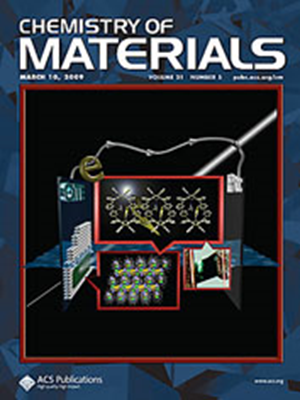Ordered Cationic Mixing in a 1D Organic–Inorganic Hybrid
IF 7.2
2区 材料科学
Q2 CHEMISTRY, PHYSICAL
引用次数: 0
Abstract
Hybrid metal halides are a remarkably dynamic family of materials that offer a flexible platform for exploring the novel crystal chemistry that emerges at the intersection of organic and inorganic solids. Herein, we report the discovery of a hybrid that contains two molecules effectively adopting isostructural geometry, (1-NA)PbI3 and (1-MQ)PbI3, and our attempts to create solid solutions of the two beyond the 1:1 ratio. Single-crystal X-ray diffraction, combined with solid-state NMR measurements, clearly show that despite having nearly identical steric geometry, the only mixed phase attained was the composition (1-MQ)(1-NA)Pb2I6, which exhibits a high degree of order between the two molecules. We propose that this ordering is primarily driven by local molecular dipoles, which ultimately creates a band structure in the blended phase that is highly characteristic of the end members, with little sign of rehybridization between the organic or inorganic components.

一维有机-无机杂化物中的有序阳离子混合
本文章由计算机程序翻译,如有差异,请以英文原文为准。
求助全文
约1分钟内获得全文
求助全文
来源期刊

Chemistry of Materials
工程技术-材料科学:综合
CiteScore
14.10
自引率
5.80%
发文量
929
审稿时长
1.5 months
期刊介绍:
The journal Chemistry of Materials focuses on publishing original research at the intersection of materials science and chemistry. The studies published in the journal involve chemistry as a prominent component and explore topics such as the design, synthesis, characterization, processing, understanding, and application of functional or potentially functional materials. The journal covers various areas of interest, including inorganic and organic solid-state chemistry, nanomaterials, biomaterials, thin films and polymers, and composite/hybrid materials. The journal particularly seeks papers that highlight the creation or development of innovative materials with novel optical, electrical, magnetic, catalytic, or mechanical properties. It is essential that manuscripts on these topics have a primary focus on the chemistry of materials and represent a significant advancement compared to prior research. Before external reviews are sought, submitted manuscripts undergo a review process by a minimum of two editors to ensure their appropriateness for the journal and the presence of sufficient evidence of a significant advance that will be of broad interest to the materials chemistry community.
 求助内容:
求助内容: 应助结果提醒方式:
应助结果提醒方式:


